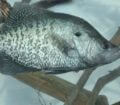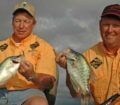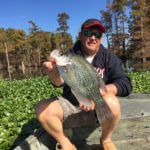Editor’s Note: Whitey Outlaw of Gaston, South Carolina, fishes on Santee Cooper often and also fishes in crappie-fishing tournaments across the U.S. Today Outlaw gives us a February pattern for fishing Santee Cooper Lake that will work in your area on a grass lake.
John in the Wild: Whitey, what grass lake do you fish?
 Outlaw: I’m fortunate that Santee Cooper Lake where I fish often is like two lakes in one. The north end of the lake consists of swamps, cypress trees and tremendous amounts of floating vegetation. Also, it’s fairly shallow compared to the lower end of the lake. The upper end of Santee Cooper can be classified as a typical grass lake. At this time of year, we try to get into the middles of the creeks that run all the way up into the swamp. Also, we try to find deep creek channels, which may only be 9- to 10-feet deep, with the thickest grass we can find over them. This grass will be floating over stumps, bushes and cypress roots, and the fish will be under the grass. On a 10-foot bottom, the crappie generally will be holding at 9-feet deep.
Outlaw: I’m fortunate that Santee Cooper Lake where I fish often is like two lakes in one. The north end of the lake consists of swamps, cypress trees and tremendous amounts of floating vegetation. Also, it’s fairly shallow compared to the lower end of the lake. The upper end of Santee Cooper can be classified as a typical grass lake. At this time of year, we try to get into the middles of the creeks that run all the way up into the swamp. Also, we try to find deep creek channels, which may only be 9- to 10-feet deep, with the thickest grass we can find over them. This grass will be floating over stumps, bushes and cypress roots, and the fish will be under the grass. On a 10-foot bottom, the crappie generally will be holding at 9-feet deep.
JITW: How are you rigging to catch these crappie in February?
Outlaw: I’ll use either an 8- or a 10-pound-test line with a 1/32-ounce tube jig, and I won’t tip the tube with a minnow. The crappie want small baits, and if they’re holding where I’m jigging, they’ll take the tube.
JITW: How are you getting that tube through the grass?
Outlaw: We use a piece of pipe with a hook on it to dig a hole through the grass.
JITW: Why doesn’t digging a hole through the grass spook the fish?
Outlaw: Remember, we’re fishing a 10-foot bottom, and the crappie are looking up. Digging the hole through the grass is much like chumming, because if you’re digging that hole, you’re knocking loose insects, grass shrimp and other critters crappie eat. These bottom fish are looking up, hoping that a wave or something will shake that grass and knock some food down to them. So, when this bait begins to rain down on them, they start looking up to see the bait as it comes to the bottom. We’re fishing about 1-foot above the fish holding on the bottom because the crappie are looking up for the bait.
 To be successful, the secret is to fish right on top of those crappie. The water’s cold, the crappie’s metabolism has slowed down tremendously, and they won’t chase bait very far. Therefore, getting the jig on top of the crappie is critical to your success. For instance, we may find a grass bed floating on the surface that’s as big as an automobile. We may have to dig 10 holes in that patch of grass to find one hole that the crappie are holding under and looking up for the food.
To be successful, the secret is to fish right on top of those crappie. The water’s cold, the crappie’s metabolism has slowed down tremendously, and they won’t chase bait very far. Therefore, getting the jig on top of the crappie is critical to your success. For instance, we may find a grass bed floating on the surface that’s as big as an automobile. We may have to dig 10 holes in that patch of grass to find one hole that the crappie are holding under and looking up for the food.
JITW: How are you finding the creek runs to fish?
Outlaw: In the upper end of Santee Cooper, the only way a boat can travel is through those creek runs. So, the creek runs are fairly open. You’ll often see big grass beds that come off the bank and stick out into the creek run or big grass beds hung up on the bottoms of cypress trees out in the water, which are all prime targets for crappie.
JITW: What color jigs are you using?
Outlaw: The color of jig is determined by the clarity of the water. If we’ve had winter rains, and the water is somewhat dingy, we’ll use darker colors, like black and chartreuse or orange and green. If the water’s fairly clear, we’ll use white and chartreuse.
JITW: What size crappie are you catching during February in Santee Cooper’s grass?
Outlaw: We catch numbers of 1-3/4- to 3-pound crappie. The rule of thumb we use is that if we’re fishing a grass bed and start catching little crappie, then we leave that grass bed, because most likely, that entire school will consist of little crappie. If we dig a hole and catch a few quality crappie there, then we know this grass bed is holding bigger crappie, and we’ll stay with this hole. I’ve caught as many as 84-nice-sized crappie from one hole in the grass. But a typical hole in the grass generally will produce three to five quality crappie.
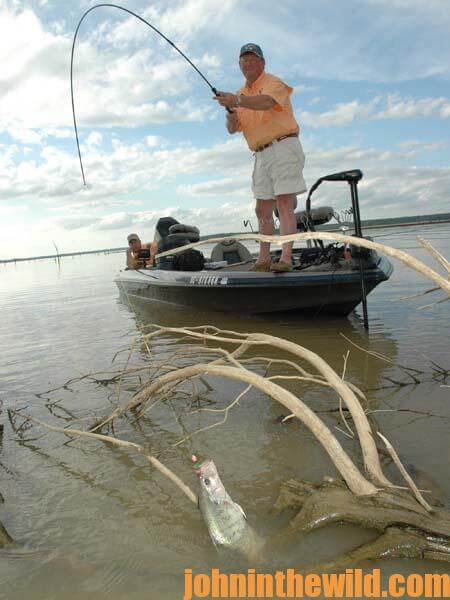 JITW: Whitey, do you dig one hole and fish through it and then dig another hole when the fish stop biting?
JITW: Whitey, do you dig one hole and fish through it and then dig another hole when the fish stop biting?
Outlaw: No. When we decide to fish a grass bed, we usually dig four or five holes in that grass bed before we start fishing. To continue to catch crappie from a grass hole, once we’re finished fishing a grass bed with holes in it that we’ve dug, we’ll ease our boat out of that bed without destroying the beds or the holes. We don’t drive through the grass beds or the holes where we’ve caught crappie, because if we catch crappie in those holes today, we probably can catch more crappie there tomorrow. We never drive through the grass beds where we’ve dug holes. If you don’t destroy a grass bed that’s producing crappie, you often can fish those same holes throughout the winter, the spring and part of the summer and consistently catch crappie from them. Our holes are only about 4 inches in diameter, so they’re not very big. Many people drive by our holes without even knowing they’re there.
JITW: What pole do you use to fish the holes?
Outlaw: We use the B‘n’M (https://www.bnmpoles.com/products/se) Whitey Outlaw Series Santee Elite pole. On this pole, the line goes through the pole and out the end without any guides. I prefer this pole when I’m hand-pole fishing anywhere at anytime. If your jig gets hung, you can slide the pole down to the jig and bump the jig off the cover without worrying about damaging the guides on the pole, because there aren’t any guides. Also, this pole doesn’t separate like the jointed poles do. It’s one solid pole, which means you don’t have to worry about putting the pole back together, like you do with a pole with guides. If a guide gets caught on a limb or a brush, that will pull the pole apart. With the Santee Elite pole, I can hold the jig at the tip of the pole, put the pole over the hole and drop the jig straight down, often through a tiny hole.
The other advantage to this pole is the amount of backbone in the pole. The trick to getting the crappie out of these grass holes is that as soon as the crappie hits the jig, you want to set the hook and bring the crappie out of the hole and into the boat. Even if you’re catching 2-pound crappie or bigger, if you’re using 8- to 10-pound-test line, this pole has the power to pull the crappie up from the bottom, through the hole in the grass and straight into the boat without the fish getting hung in the grass. If you let a crappie swim around in the grass while you’re waiting to get a dip net, you’ll lose it just about every time. The Santee Elite pole has been designed to fish through thick cover and grass, and it also has the power to bring those big fish into the boat quickly.

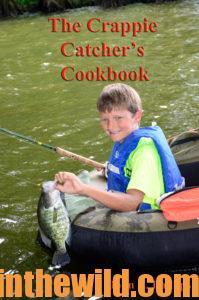 To learn more about crappie fishing, see John E. Phillips’s books in Kindle, print and/or Audible forms, including “Catch Crappie All Year: Fishing a Single Pole, Using No Boat and Farming Crappie” (http://amzn.to/1DBpnNh). To receive and download for free “The Crappie Catchers’ Cookbook,” by John and Denise Phillips, go to https://johninthewild.com/free-books.
To learn more about crappie fishing, see John E. Phillips’s books in Kindle, print and/or Audible forms, including “Catch Crappie All Year: Fishing a Single Pole, Using No Boat and Farming Crappie” (http://amzn.to/1DBpnNh). To receive and download for free “The Crappie Catchers’ Cookbook,” by John and Denise Phillips, go to https://johninthewild.com/free-books.

